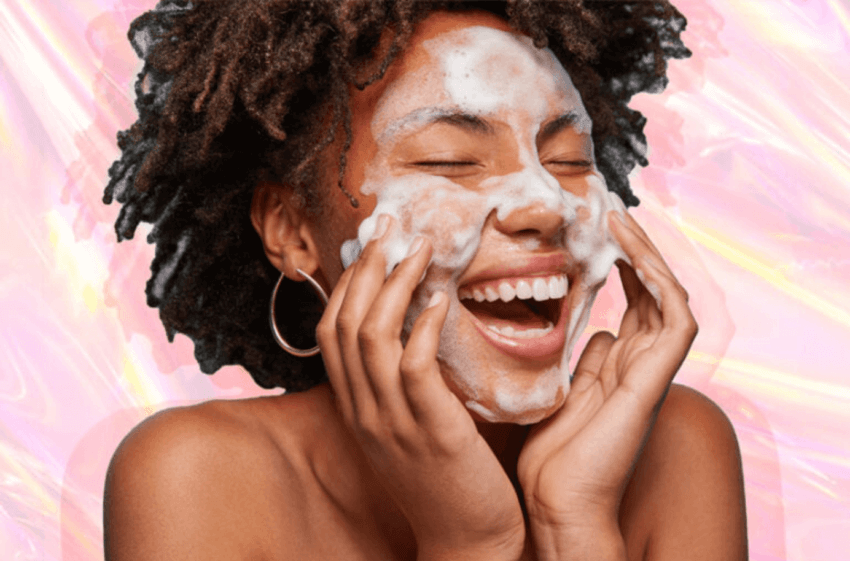What Is A Cryofacial & How To Do One At Home
 via Giphy
via Giphy
The skincare industry has no shortage of wacky-sounding treatments, products, and ingredients. You can poke yourself with tiny needles via dermarollers, give yourself a legit face workout with Skin Gym, and harness the power of cold via a “cryofacial.” Today we’re talking all about the lattermost of those, and if you haven’t yet heard of this chilly treatment then you’re in for a pretty cool treat.
What is a Cryofacial?
View this post on Instagram
A traditional, in-office cryofacial is a type of cryotherapy treatment where very cold air is used to cool skin on your face, scalp, and neck. There are two primary types – liquid nitrogen and purified cold air by electricity – and each has their own set of pros and cons.
Liquid Nitrogen Cryofacial: The liquid nitrogen is cooled to about -200 degrees Celsius (-328 Fahrenheit) and then vaporized so that it’s at a safer temperature for your skin. Then the nitrogen is gently dispersed through a fancy hose directly to your skin.
“The hose is moved quickly over the face and held far enough away that it won’t freeze-burn the skin. It does not feel unbearably cold – more like a cool stream of air – but it will feel colder as the 10-minute treatment progresses,” explains Dr. Hadley King, a NYC-based board-certified dermatologist.
Purified Cold Air Cryofacial: Liquid nitrogen machines are powerhouses and technically provide colder air, but they do require a nitrogen tank that’s tricky to store properly. In cases where a nitrogen tank can’t be stored due to safety concerns, purified air powered by electricity is an excellent alternative.
“At 111Skin, we follow specific movements to cool the skin long enough, so we can trigger a proper response, [such as] increasing microcirculation, reducing puffiness, and stimulating the healing process,” says Milena Naydenov, facialist for 111Skin. “[We believe our] cryo machine is safer to the environment and patient, it is more convenient for storage, and it delivers instant results.”
What’s the Point of a Cryofacial?
This skin treatment is a nice treat on a hot or muggy day, but the benefits don’t stop at a refreshing cool off.
“Cryofacials are meant to reduce inflammation, tighten pores, and remove stagnant lymphatic fluid that can cause puffiness, a fuller face, and bags under the eyes,” says Rachel Lee Lozina, licensed esthetician and founder of Blue Water Spa & Boutique in Oyster Bay, New York. “These facials are amazing for all skin types. However, results are more apparent if you have underlying inflammatory skin issues such as puffiness, acne, or rosacea.”
(To clear up some confusion, note that cryofacials are completely different from Coolsculpting. The latter is a much more aggressive treatment that involves freezing fat between metal plates to the point that it actually kills fat cells (apoptosis). Its primary goal is to reduce fat volume – not to improve skin radiance.)
Are All Cryofacials the Same?
The short answer to this is no. Traditionally, cryofacials involve cold, vaporized nitrogen or purified air, as outlined above. However, there are cryofacial alternatives both in-office and that you can do to yourself at home. These alternative approaches typically involve using special, chilly tools on the skin, including cryosticks, cold rollers and massagers, and even frozen eye masks. Plain old ice is sometimes used, as well.
How to Do a Cryofacial At Home
The benefit to having a cryofacial performed professionally is that it’s a controlled setting that typically involves colder temperatures and therefore delivers more dramatic results. That said, you can totally DIY a “baby cryofacial” at home. If you’re game, you’ll probably want to invest in a few tools to get the job done, and it’s also important to follow some basic ground rules.
As far as tools, we recommend any of the following:

- Fraîcheur Ice Globes Cooling Facial Tool Collection, $50
- Stacked Skincare Cryotherapy Ice Roller, $24, or the smaller Sonia Kashuk™ Facial Ice Roller, $10
- Spa Relaxus Thermal Ice Bead Cooling Eye Mask, $10
Another option is to use ice cubes wrapped in cloth, cold metal spoons, chilled jade rollers. You can even put your favorite hydrating mask in the fridge or try a product that’s formulated to be automatically cooling, such as Lancôme Rose Sorbet Cryo-Mask, $39.
Most over-the-counter products and tools have instructions, so follow those closely. As a general rule, though, Naydenov says to apply a nice serum first and then gently push whatever item you’re using in an upward motion across your skin. Don’t tug, and never push downward since that can result in a temporary sagging appearance. Repeat several times over each section. You can follow this helpful video for more guidance.
One final word to the wise: When giving yourself a chilly cryofacial at home, make sure to never use anything that could potentially freeze-burn the skin. You should experience only a soothing sensation – never any pain. It also probably goes without saying, but just in case: never ever apply dry ice (a solid form of carbon dioxide) to your skin. “It can cause severe damage to the skin leading to ulcerations and scars,” warns NYC board-certified dermatologist Dr. Joshua Zeichner.
Bottom line: be safe, chill out, and have fun!
Disclaimer: Every product we review has been independently selected and tested without bias by our editorial team. We never take payment to review products, however, some brands allow affiliate links, so we may earn a commission if you purchase a product by clicking on one of our links.





















Leave a comment